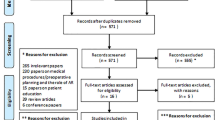Abstract
Purpose
Reviews and meta-analyses concerning the effectiveness of extended reality technologies (ERTs) (namely virtual, augmented, and mixed reality-VR, AR, and MR) in anatomy education (AE) have resulted in conflicting outcomes. The current review explores the existing evidence provided by reviews of AE literature regarding the effectiveness of ERTs after their comparison with traditional (either cadaveric or two-dimensional) anatomy teaching modalities and sheds light on the factors associated with the conflicting outcomes.
Methods
PubMed, SCOPUS, ERIC, and Cochrane databases were searched for review articles with the purpose to investigate the effectiveness of ERTs in AE.
Results
Nine (four systematic with or without meta-analysis and five non-systematic) reviews were included. A lack of robust evidence provided by those reviews was noted, mainly due to a remarkable confusion in the definition of each ERT, along with confusion when authors referred to traditional AE (TAE) methods.
Conclusions
To clarify to what extent VR, AR, or MR can replace or supplement TAE methods, there is a primary need for addressing issues regarding the definition of each technology and determining which specific TAE methods are used as comparators.
Similar content being viewed by others
Abbreviations
- ERTs:
-
Extended reality technologies
- VR:
-
Virtual reality
- AR:
-
Augmented reality
- MR:
-
Mixed reality
- AE:
-
Anatomy education
- TAE:
-
Traditional anatomy education
- 3D:
-
Three-dimensional
- 2D:
-
Two-dimensional
- VDTs:
-
Virtual dissection tables
References
Bölek KA, De Jong G, Henssen D (2021) The effectiveness of the use of augmented reality in anatomy education: a systematic review and meta-analysis. Sci Rep 11:15292
Brigham TJ (2017) Reality Check: Basics of Augmented, Virtual, and Mixed Reality. Med Ref Serv Q 36:171–178
Chytas D, Johnson EO, Piagkou M, Mazarakis A, Babis GC, Chronopoulos E, Nikolaou VS, Lazaridis N, Natsis K (2020) The role of augmented reality in Anatomical education: an overview. Ann Anat 229:151463
Chytas D, Salmas M, Skandalakis GP, Troupis T (2022) Augmented and virtual reality in anatomy education: Can they be effective if they do not provide immersive experience? Anat Sci Educ 15:431–433
Deng X, Zhou G, Xiao B, Zhao Z, He Y, Chen C (2018) Effectiveness evaluation of digital virtual simulation application in teaching of gross anatomy. Ann Anat 218:276–282
Duarte ML, Santos LR, Guimarães Júnior JB, Peccin MS (2020) Learning anatomy by virtual reality and augmented reality. A scope review. Morphologie 104:254–266
Goo HW, Park SJ, Yoo SJ (2020) Advanced medical use of three-dimensional imaging in congenital heart disease: augmented reality, mixed reality, virtual reality, and three-dimensional printing. Korean J Radiol 21:133–145
Karbasi Z, Niakan Kalhori SR (2020) Application and evaluation of virtual technologies for anatomy education to medical students: A review. Med J Islam Repub Iran 34:163
Moro C, Birt J, Stromberga Z, Phelps C, Clark J, Glasziou P, Scott AM (2021) Virtual and augmented reality enhancements to medical and science student physiology and anatomy test performance: a systematic review and meta-analysis. Anat Sci Educ 14:368–376
Moro C, Štromberga Z, Raikos A, Stirling A (2017) The effectiveness of virtual and augmented reality in health sciences and medical anatomy. Anat Sci Educ 10:549–559
Romand M, Dugas D, Gaudet-Blavignac C, Rochat J, Lovis C (2020) Mixed and augmented reality tools in the medical anatomy curriculum. Stud Health Technol Inform 270:322–326
Skandalakis GP, Chytas D, Paraskevas G, Noussios G, Salmas M, Fiska A (2021) Virtual and augmented reality in anatomy education: need for comparison with other three-dimensional visualization methods. Morphologie S1286–0115(21):00030–00038
Taylor L, Dyer T, Al-Azzawi M, Smith C, Nzeako O, Shah Z (2021) Extended reality anatomy undergraduate teaching: a literature review on an alternative method of learning. Ann Anat 239:151817
Uruthiralingam U, Rea PM (2020) Augmented and virtual reality in anatomical education—a systematic review. Adv Exp Med Biol 1235:89–101
Zhao J, Xu X, Jiang H, Ding Y (2020) The effectiveness of virtual reality-based technology on anatomy teaching: a meta-analysis of randomized controlled studies. BMC Med Educ 20:127
Funding
No funding was received.
Author information
Authors and Affiliations
Contributions
DC: project development, data collection and analysis, manuscript writing, editing, and revision; MP: data analysis, manuscript writing, editing, and revision; TD and GT: manuscript editing; KN: manuscript editing and supervision. All the authors approved the final draft of the paper.
Corresponding author
Ethics declarations
Competing interests
The authors declare no competing interests.
Conflict of interest
The authors declare that there is no conflict of interest.
Ethics approval and consent to participate
Not applicable.
Consent for publication
Not applicable.
Additional information
Publisher's Note
Springer Nature remains neutral with regard to jurisdictional claims in published maps and institutional affiliations.
Rights and permissions
Springer Nature or its licensor holds exclusive rights to this article under a publishing agreement with the author(s) or other rightsholder(s); author self-archiving of the accepted manuscript version of this article is solely governed by the terms of such publishing agreement and applicable law.
About this article
Cite this article
Chytas, D., Piagkou, M., Demesticha, T. et al. Are extended reality technologies (ERTs) more effective than traditional anatomy education methods?. Surg Radiol Anat 44, 1215–1218 (2022). https://doi.org/10.1007/s00276-022-02998-5
Received:
Accepted:
Published:
Issue Date:
DOI: https://doi.org/10.1007/s00276-022-02998-5




